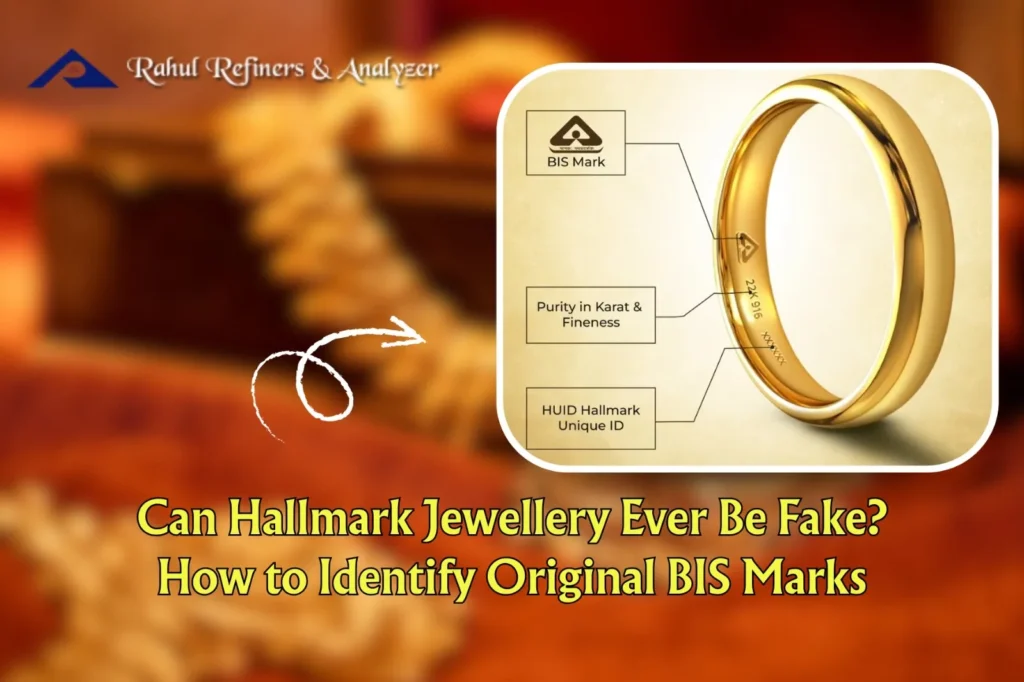RahulRefinery
14.01.2025
Technology to Determine Gold Purity
Hello Reader!
Welcome to the blog page Rahul Refinery, one of the best gold refining company in Kolkata.
Gold is a precious metal cherished worldwide for its beauty, value, and enduring appeal. Over centuries, gold has been a symbol of wealth and prosperity, often used for jewelry, investments, and even as currency. However, when purchasing or refining gold, one of the most important aspects to consider is its purity. Gold purity determines the quality and value of the metal, and accurately assessing it requires the use of sophisticated technology.
At Rahul Refinery, the best gold refining company in Kolkata, we understand the significance of ensuring the purity of gold. We employ cutting-edge technologies to guarantee that our customers receive nothing but the finest quality. In this blog, we will discuss the various technologies available today to determine gold purity and why these methods are so important.
Table of Contents

What Is Gold Purity?
Gold purity is a measure of how much pure gold is present in a piece of gold alloy. Pure gold is 24-karat (24K) gold, which means it is 99.9% pure gold. However, gold used in jewelry or coins often contains other metals like silver, copper, or zinc to enhance durability and strength. The purity of gold is typically measured in karats (K) or fineness (a decimal number). For example, 18K gold is 75% pure gold, and 22K gold is about 91.7% pure.
Determining gold purity accurately is crucial for both buyers and sellers. For this reason, the technology used for testing gold purity is constantly evolving to ensure greater accuracy and reliability.
Technologies Used to Determine Gold Purity
1. X-Ray Fluorescence (XRF) Spectroscopy
One of the most advanced and widely used methods to determine gold purity is X-ray fluorescence (XRF) spectroscopy. This non-destructive technique involves exposing the gold sample to X-rays, which cause the atoms in the gold to emit secondary (or fluorescent) X-rays. These emitted X-rays are then measured to determine the metal composition.
XRF technology is popular among the best gold refining company in Kolkata, like Rahul Refinery, due to its accuracy, speed, and non-invasive nature. It allows the testing of gold without altering or damaging the piece being tested. XRF analysis gives an immediate reading of gold purity and the presence of other metals in the alloy, providing a detailed report on the composition.
2. Fire Assay Method
The fire assay method, known as the most reliable traditional technique, has been used for centuries to determine gold purity. This method involves heating a small sample of gold in a furnace with a flux that separates impurities from the gold. The result is a pure gold bead, and its weight is measured to determine the purity of the original sample.
While this technique is accurate and trusted, it is a destructive method, meaning it cannot be used for items of significant value like jewelry. However, fire assay remains a standard in the industry and is especially important when dealing with large quantities of gold.
3. Cupellation Method
The cupellation method is another traditional technique used to test gold purity. In this method, a sample of gold is heated in a porous container (called a cupel) along with a mixture of lead. The lead absorbs the impurities, and the pure gold remains behind. The weight of the gold is then measured to determine its purity.
This method is more labor-intensive and time-consuming compared to modern techniques like XRF, but it is still used by some refineries, including the best gold refining company in Kolkata, as it can yield highly accurate results for certain types of gold samples.
4. Acid Test
The acid test is a relatively simple and low-cost method used to assess gold purity. It involves applying a drop of nitric acid or a mixture of acids to the gold sample. Depending on the reaction, the purity of the gold can be inferred. For example, pure gold will not react with nitric acid, while lower-karat gold alloys may show signs of corrosion or discoloration.
Although the acid test can give a quick indication of gold purity, it is less accurate than other methods like XRF or fire assay. Additionally, the acid test can damage the item being tested, making it unsuitable for high-value jewelry.
5. Electronic Gold Testing
Electronic gold testers are another modern tool used to measure gold purity. These handheld devices use electrical resistance to estimate the purity of the metal. The device measures how easily an electrical current passes through the sample, which varies depending on the metal’s composition. The results are then displayed as the karat value or percentage of pure gold in the sample.
Electronic gold testers are quick, easy to use, and non-destructive, making them popular for small-scale testing. However, they are generally less precise than XRF spectrometers and can sometimes give inaccurate readings for certain alloys.
6. Laser-Induced Breakdown Spectroscopy (LIBS)
Laser-induced breakdown spectroscopy (LIBS) is an emerging technology that uses a high-powered laser to vaporize a small portion of the gold sample. The vaporized material is then analyzed to determine the gold’s elemental composition. This method is fast, non-destructive, and highly accurate, making it ideal for high-end gold refining companies like Rahul Refinery, the best gold refining company in Kolkata.
LIBS provides highly detailed information about the composition of gold, including trace elements and other metals present in the alloy. It is becoming increasingly popular for gold purity testing because of its precision and ability to analyze small amounts of material without altering the sample.

What are the advantages of using X-ray Fluorescence (XRF) for gold purity testing?
X-ray fluorescence (XRF) technology has become a cornerstone in the field of gold purity testing due to its numerous advantages. Here are the key benefits of using XRF for determining gold purity:
1. Non-Destructive Testing
One of the most significant advantages of XRF is its non-destructive nature. Unlike traditional methods that may require sampling or scratching the surface of the item, XRF allows for the analysis of gold without altering or damaging it. This feature is particularly important for high-value items, such as jewelry and artifacts, ensuring that their integrity and value remain intact during testing.
2. Rapid and Accurate Results
XRF machines provide near-instantaneous results, allowing users to determine gold purity quickly. The technology can accurately identify impurities and alloying elements down to trace levels within seconds. This speed enables jewelers, refiners, and researchers to make informed decisions promptly, enhancing operational efficiency.
3. Versatility in Testing
XRF analyzers are versatile and can test a wide range of gold items, including jewelry, bullion, coins, and other artifacts. They can handle various shapes and sizes, accommodating both small samples and larger pieces. Additionally, XRF can analyze gold alloys, providing precise information about the composition of different metals within a mixture.
4. High Precision
The accuracy of XRF technology is noteworthy; it can deliver results with a measurement error as low as ±0.1% for pure gold. This precision eliminates the guesswork associated with traditional testing methods like acid testing, ensuring that buyers and sellers can trust the results.
5. Cost-Effectiveness
While the initial investment in XRF equipment may be significant, the long-term cost savings are substantial. The ability to perform non-destructive analysis and generate quick results reduces time and resource expenditures compared to traditional methods or laboratory testing.
6. Health and Environmental Benefits
XRF testing does not involve harmful chemicals or acids, making it a safer option for both operators and the environment. There is no risk of chemical exposure or the need for hazardous waste disposal, contributing to a safer workplace and reducing environmental contamination.
7. Gold Plating Detection
XRF technology excels in identifying gold-plated items versus solid gold. Advanced algorithms within XRF devices can differentiate between these two types of items effectively, ensuring greater transaction transparency and providing peace of mind for both buyers and sellers.
Also Read: Jewelry Manufacturing Inspections: What You Need to Know

How does acid testing compare to electronic conductivity testing in terms of accuracy?
When comparing acid testing and electronic conductivity testing for determining gold purity, several factors influence their accuracy and effectiveness. Here’s a detailed analysis of both methods:
Acid Testing
Overview: Acid testing involves applying specific acids to a small scratch on the gold item. The reaction of the acid with the metal indicates its purity based on the color change or reaction observed.
Advantages:
- Simplicity: Acid testing is straightforward and does not require complex equipment.
- Cost-Effective: It is relatively inexpensive compared to advanced technologies.
Limitations:
- Destructive Nature: This method leaves a mark on the gold item, which can be undesirable, especially for high-value pieces.
- Accuracy Variability: The accuracy can vary significantly depending on the skill of the person performing the test and environmental factors. It may not reliably differentiate between similar karat values.
- Limited Detection Range: Acid testing may not effectively identify lower concentrations of impurities or alloys, leading to potential inaccuracies in results.
Electronic Conductivity Testing
Overview: Electronic conductivity testing measures the ability of gold to conduct electricity, which correlates with its purity. This method uses a conductivity meter that provides a reading based on the electrical current passing through the sample.
Advantages:
- Non-Destructive: Unlike acid testing, electronic conductivity testing does not damage the item being tested.
- High Precision: This method can provide more consistent and accurate results, particularly for detecting small variations in purity levels. It can measure down to very low concentrations of impurities accurately.
- Rapid Results: Electronic conductivity testing typically yields immediate results, allowing for quick assessments.
Limitations:
- Equipment Cost: The initial investment in conductivity meters can be higher than that for acid testing.
- Calibration Required: Accuracy depends on proper calibration of the equipment and may require regular maintenance.
Comparative Accuracy
In terms of accuracy, electronic conductivity testing generally outperforms acid testing due to its ability to provide precise measurements without damaging the sample. While acid testing can offer quick insights, its reliance on visual interpretation and potential for human error can lead to inaccuracies.
Moreover, electronic conductivity testing is less subjective and more consistent across different operators, making it a preferred choice among professionals in gold refining and trading. For businesses like Rahul Refinery, recognized as the best gold refining company in Kolkata, utilizing advanced methods such as electronic conductivity testing ensures reliable assessments of gold purity that clients can trust.

Why Accurate Gold Purity Testing Matters
Accurate determination of gold purity is essential for several reasons:
- Fair Transactions: Gold buyers and sellers need to ensure that the gold they are trading matches the stated purity. Misrepresentation can lead to financial losses.
- Quality Assurance: Jewelry makers and gold manufacturers need to verify the purity of gold before creating products, ensuring high-quality finished goods.
- Investment Security: Investors who purchase gold as a hedge against inflation or as a long-term investment need to be certain of the metal’s purity, as it directly affects the value of their holdings.
- Refining Processes: Gold refining companies, like Rahul Refinery, rely on accurate purity testing to ensure that they extract maximum value from the gold they refine. Accurate measurements also ensure the proper separation of precious metals from impurities.

FAQ
- What is the best technology to determine gold purity?
- The best technology for determining gold purity is X-ray fluorescence (XRF) spectroscopy. It provides accurate, fast, and non-destructive analysis of gold composition.
- Is the acid test reliable for determining gold purity?
- The acid test can provide a quick indication of gold purity, but it is less accurate compared to methods like XRF or fire assay and can damage the gold sample.
- How does XRF technology work to test gold purity?
- XRF technology uses X-rays to analyze the sample’s composition. The emitted fluorescent X-rays are measured to determine the gold’s purity and the presence of other metals.
- What is the fire assay method, and how accurate is it?
- The fire assay method involves heating gold with a flux to separate impurities. It is one of the most accurate traditional methods but is destructive, meaning it cannot be used for valuable jewelry.
- Can electronic gold testers provide precise purity measurements?
- Electronic gold testers are quick and easy to use but are less precise than XRF or fire assay methods. They are suitable for small-scale testing but may not provide highly accurate results for complex alloys.
Conclusion
Determining gold purity with precision is crucial for maintaining trust and authenticity in the gold trade. Technologies like X-ray fluorescence (XRF), fire assay, and laser-induced breakdown spectroscopy (LIBS) have revolutionized the gold purity testing process, ensuring that buyers, sellers, and refiners can confidently assess the value of gold.
At Rahul Refinery, the best gold refining company in Kolkata, we use state-of-the-art technology to provide accurate and reliable gold purity testing. Whether you’re refining gold, purchasing jewelry, or investing in precious metals, you can trust us to deliver the highest quality and value.
If you’re looking for the most advanced, trustworthy gold refining services, reach out to Rahul Refinery, the best gold refining company in Kolkata, and let us assist you in ensuring the purity and value of your gold.



